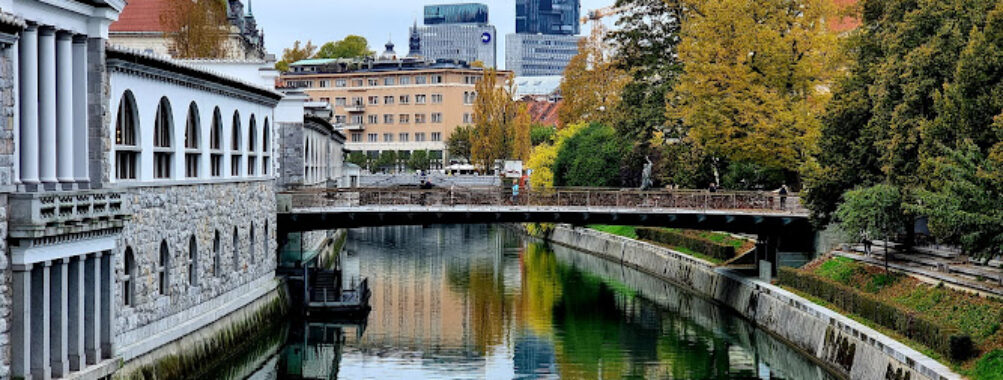
The Butchers’ Bridge
Table of Contents The Butchers’ Bridge in Ljubljana might not look like much at first glance, but give it a few minutes—this place grows on you. It’s a pedestrian bridge that stretches over the Ljubljanica River, right in the heart of Slovenia’s capital. What makes it stand out isn’t just the modern glass and steel design, but the way it connects the city’s old-world charm with its more contemporary side. I remember the first time I walked across it—I could hear the faint hum of street musicians nearby, the clinking of padlocks swaying in the breeze, and that soft murmur of the river below. There’s something oddly romantic about it, even if you’re not the sentimental type. Now, The Butchers’ Bridge has this quirky reputation as Ljubljana’s “love bridge.” Couples from all over the world come here to attach padlocks to the railings, a symbol of their love (or maybe just a fun travel ritual). Some locks are shiny and new, others rusted and weathered, telling stories of time and distance. And if you’re anything like me, you’ll probably find yourself wondering about the people behind those names and initials. Did they stay together? Did they come back years later to find their lock still hanging there? But there’s more to this bridge than just romance. It’s also a small open-air art gallery. The bronze sculptures scattered along the bridge—created by Slovenian artist Jakov Brdar—add a slightly eerie, thought-provoking vibe. They depict figures from mythology, like Adam and Eve or Prometheus, and they’re not the polished, idealized versions you might expect. They’re raw, expressive, almost unsettling in their realism. It’s a fascinating contrast—the delicate padlocks of love beside these dark, symbolic sculptures. Somehow, it all works together beautifully. And honestly, that’s kind of the charm of Ljubljana itself. It’s a city that doesn’t try too hard to impress you—it just quietly wins you over. The Butchers’ Bridge fits right into that rhythm. People stop here for photos, sure, but they also linger. They watch the riverboats glide by, listen to the chatter from the nearby Central Market, or just take a moment to breathe. It’s not a grand landmark like the Eiffel Tower or Tower Bridge, but it has its own understated magic. If you ask me, the best time to visit The Butchers’ Bridge is late afternoon, especially in spring or early autumn. The light hits the river just right, turning everything a soft gold, and the reflections off the glass panels make the whole place glow. Summer can be a bit crowded—Ljubljana gets its fair share of tourists—but the energy is lively and fun. You’ll hear buskers playing guitar, couples laughing, and maybe even a wedding photo shoot or two. Winter, on the other hand, has a quieter, almost melancholic charm. The padlocks glisten under a layer of frost, and the sculptures seem even more haunting in the cold mist. If you’re into photography, that’s your golden hour. And here’s a little personal tip: visit just after a light rain. The bridge’s glass panels reflect the sky and the city lights like a mirror. It’s honestly mesmerizing. Bring a coffee from one of the nearby cafes, lean on the railing, and just watch the world go by. Simple pleasures, right? The Butchers’ Bridge is right in the center of Ljubljana, so getting there is easy. Most visitors arrive on foot since the old town is largely pedestrian-friendly. If you’re staying nearby, you can wander through the Central Market or cross the famous Dragon Bridge—it’s just a short walk away. The bridge connects two lively parts of the city, so you’ll probably stumble upon it even if you’re not looking for it. And that’s part of the fun—Ljubljana is small enough that exploring feels effortless. You don’t need a map; just follow the river and the sound of laughter, and you’ll find it. For those using public transport, the main bus and train stations are within walking distance. Taxis and bike rentals are also available, but honestly, walking is the best way to experience the city’s cozy atmosphere. Every corner has a story—street art, market stalls, hidden courtyards—and the bridge fits perfectly into that patchwork of experiences. Alright, here’s the part where I share a few lessons learned from my own visits (and a couple of mistakes too): And one last thing: if you’re traveling solo, don’t skip it just because it’s known as a “love bridge.” There’s something oddly comforting about standing there, surrounded by thousands of stories, knowing that love—in all its messy, beautiful forms—connects people across time and distance. You don’t need someone beside you to feel that. Just being there is enough. In the end, The Butchers’ Bridge isn’t about grandeur or spectacle. It’s about small moments—the sound of the river, the weight of a lock in your hand, the way art and emotion intertwine in the middle of a city that feels both ancient and modern. Whether you’re a hopeless romantic, an art lover, or just someone who enjoys finding beauty in unexpected places, this bridge will leave an impression that lingers long after you’ve crossed it.Description
Key Features
Best Time to Visit
How to Get There
Tips for Visiting
Location
Places to Stay Near The Butchers' Bridge
Find and Book a Tour
Explore More Travel Guides
No reviews found! Be the first to review!